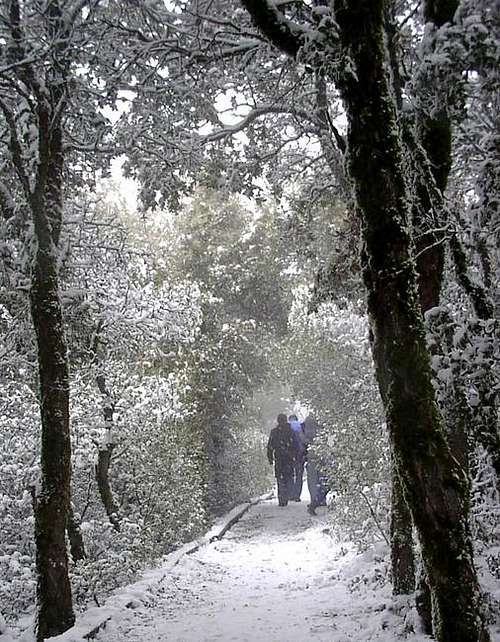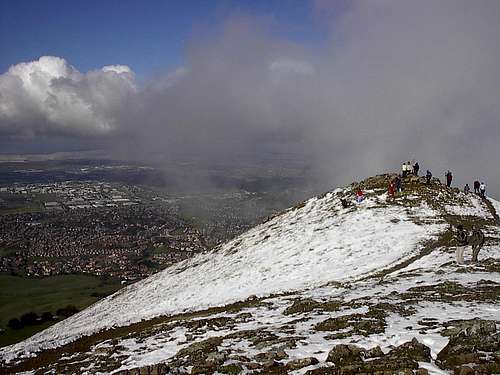-
 71898 Hits
71898 Hits
-
 86.37% Score
86.37% Score
-
 22 Votes
22 Votes
|
|
Area/Range |
|---|---|
|
|
37.50000°N / 122°W |
|
|
Hiking, Trad Climbing, Sport Climbing, Toprope, Bouldering, Aid Climbing, Scrambling |
|
|
Spring, Summer, Fall, Winter |
|
|
The San Francisco Bay Area
East Bay
The East Bay Area peaks are characterized by velvety green hills in the spring with abundant wildflowers, hot summers with dry grasses blowing in the wind, pleasant falls as the temperatures become more tolerable, and varied winters depending on rainfall and local weather. The two highest and perhaps most popular training peaks in the East Bay are Mt. Diablo off of Hwy. 680 and Mission Peak in Fremont. Both offer substantial vertical elevation gain and are excellent for a nearby workout. Mission Peak tends to be very crowded with fewer options as far as trails. Mission Peak is also lower in elevation. Mt. Diablo, however, offers more variety and even have technical rock climbing located at the Boy Scout Rocks area. Some routes on Mt. Diablo rarely see much traffic.
Fall, winter, and spring offer the best hiking in the East Bay. Summer can be oppressively hot. If you plan on climbing one of the East Bay peaks in the summer, prepare for intense heat and try to climb early. Spring wildflowers can be overpoweringly beautiful and perhaps provide the most beautiful time of year to hike. Winter is also a great time to hike; a rainy day can scare most locals away and give you a sense of wilderness seldom found so close to an urban area.
South Bay
South Bay peaks typically see less hikers and climbers than North and East Bay peaks. The South Bay peaks lie either in the Diablo Range or the Santa Cruz Mountains. From the infamous private property peaks such as Mt. Umunhum, Loma Prieta, and Mt. Isabel, to off-beat climbing spots such as Guadalupe Rock and Pine Mountain, the South Bay offers many great outings for the peakbagger and outdoor enthusiast.
North Bay
Per Dingus Milktoast... (Thank you!) The North Bay Area peaks defy convenient characterization. Winters are warm and wet and green and summers are hot, dry and brown. The terrain ranges from well maintained trails to old ranch road and even cross country wilderness travel. The north bay has a little bit of everything. Mt Tamalpais or Mt Tam as the locals call it, is perhaps the single most popular peak in the north bay area. Its a coastal peak and lacks the stunning summertime heat of the inland ranges. There are some very popular trails on the peak and even a little sandstone bouldering.
Coming in from the coast, the mountains become progressively hotter and drier. The Sonoma and Mayacama Mountains, volcanic in nature, dominate Sonoma and Napa counties, the source for the rich grape producing soils. Mt St Helena is a dominating presence and offers an easy though strenuous hike up a road to the summit antenna complex. This peak typically sees many hikers on sunny weekends but not nearly the amount of traffic that Mt Tam attracts. There is also an established though modest sport climbing area along the St Helena approach road.
Farthest inland the Blue Ridge presents a nearly continuous wall of mountains running from I-80 at the Vaca Mountains near Vacaville, up through western Yolo County (Berryessa Pk, Lowrey, Fiske, Glascock) up to Colusa County and Hwy 20. The Cache Creek and Lake Berryessa wilderness areas are a stunning resource for those who like to be alone amidst millions. One can easily hike and climb in this region and not see another soul all day long. Several county highpoints are also included in this area; Marin, Sonoma, Solano, Yolo, Napa are all there for the bagging.
Snow in the Bay Area
External Links
- Bay Area Hiker page.
- Bay Area Climbers







Noondueler - Aug 28, 2015 6:22 pm - Voted 10/10
Mission Peak picposted twice.